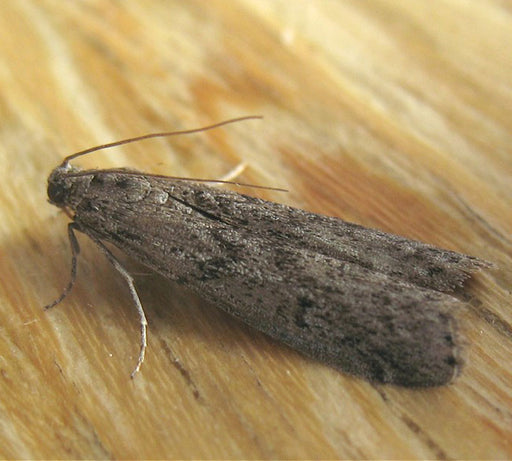The Mediterranean Pantry Moth Species - A Homeowners Guide

If you’ve ever noticed flying moths or small caterpillar-like larvae in your kitchen, maybe in an open packet of flour or in an unsealed food container - there’s a good chance that you’ve come face to face with a Pantry Moth infestation. Identification of the type of moth is the first step to eradication, believe it or not there are many different types of moths who’d love to call your home theirs!
There are two main species of Pantry Moths that will readily ruin your food and pantry—the Indian Meal Moth and the focus of this article; the Mediterranean Pantry Moth. Both moths are also commonly referred to as Flour Moths, as flour is a prime environment for the flying female moths to lay their eggs. This flour based nursery also provides ready access to a food source for the hungry moth larvae as they hatch.
So let’s find out a little more about this exotically named creature. To paraphrase Sun Tzu “Know thy enemy…”!
About the Mediterranean Pantry Moth
Sometimes referred to as Mediterranean Flour Moths or Ephestia Kuehniella, these moths are common throughout the US and Europe - so not just located in the Mediterranean. The Mediterranean Pantry Moth is considered a highly damaging pest, especially in the kitchen or other rooms in your home where you’d store food. Although adult Pantry Moths cannot eat food themselves (as they have no mouth), the larvae that hatch from moth eggs can devour cereals, beans, chocolate, flour, grains, biscuits, nuts, dry pet food, bird seed, dried fruits… basically, they’re not particularly fussy eaters!
The damage the Mediterranean Pantry Moth larvae cause can seem so significant because they’re not easily noticed. They leave mats and tangled webs within the food they are eating and this is often how people find out they have a Mediterranean Flour Moth problem.
Mediterranean Pantry Moth Characteristics
Even though the Mediterranean Flour Moth looks very similar to other House Moths, like the Indian Meal Moth, there are some differences in their appearance.
The adult Mediterranean Pantry Moths have pale-gray wings and off-white legs. They’re about 6-12 mm (3/4-inch) long, and they have a wingspan of 23 mm (1 inch) wide. Also, look at their wings. If you see two fuzzy zigzags, you know you have Mediterranean Flour Moths flying around.
Mediterranean Pantry Moth larvae are either pink or light brown in color, and have a dark brown head.
Mediterranean Pantry Moth Life Cycle
A female moth can lay anywhere from 100-200 eggs on average, though some can lay 600 or more. The small white eggs are attached to any of the aforementioned food sources or to the bags and boxes of food.
In about 3 days (requiring warmer temperatures of 80 to 90°F or 25 to 30°C), the eggs hatch into larvae. Immediately, they start to eat and spin their silken webbing. They will continuously eat and spin tubing until they are fully matured—within 40 days.
They transform into pupae and remain that way for 8-12 days. Then, the adult Flour Moth emerges ready to mate and lay eggs.
The full life cycle of a Mediterranean Pantry Moth takes about 5-7 weeks.
How To Control a Mediterranean Pantry Moth Problem
The first step to controlling an infestation is to inspect the places where you suspect the moths are present. Empty your pantry and cabinets and look out for any signs of cocoons, webbing, frass, and adult moths. Examine all exposed food packages. If you find any food contaminated with webbing it should not be consumed.
As soon as you purchase food, store it in sealed containers. Always eat your oldest stored food items first. The longer you keep your foodstuffs the higher the chance of Pantry Moth larvae establishing an infestation in your pantry.
Next, you should thoroughly vacuum the entire pantry. Pay particular attention to shelves, corners, cracks, unused shelf support holes, and baseboard. Pantry Moths lay their eggs in all kinds of places. It’s also recommended to clean the area with white vinegar or a mild detergent to kill the eggs, larvae, and pupae.
From there, you have to deal with the adult moths. One of the best methods is using a non toxic odorless pheromone Pantry Moth Trap from MothPrevention. This sticky Pantry Moth Trap shows you an estimate of the size of the infestation and helps control how many male moths are flying around, by catching the males. No males, no fertilized eggs, no new Pantry Moth Larvae.
For a larger infestation you may like to read our Pantry Moths Kit Guide for information on how to use non toxic products in line with our Traps to rid your home of Pantry Moths. It is essential that these products are safe for use in the kitchen.
Once you have your pantry under control, continue with your cleaning routine and keep an eye on the Pantry Moth Traps for signs of flying moths - as this can be a sign that the larvae have returned.
For our more detailed A-Z guide on how to get rid of Mediterranean Flour Moths, see our handy guide talking you through the above steps with even more detail.
Get Rid of Those Mediterranean Flour Moths Today
Being aware of the main characteristics of a Mediterranean Pantry Moth will help you identify this type of pantry moths and get rid of them easily. If you notice any webbing or silk tubes in your pantry containers and packets, you probably have Mediterranean Flour Moths in your home and it’s time to start discarding packets of food, thoroughly cleaning and setting up pantry moth traps.
FAQs
How do I get rid of Mediterranean Pantry Moths?
Getting rid of Mediterranean Pantry Moths requires discarding infested foods, storing unaffected items in airtight containers, inspecting and cleaning the pantry and all packaging, cleaning and vacuuming regularly, and using pheromone pantry moth traps. For a larger infestation we have detailed information about using safe non toxic products in line with our traps in our Pantry Moths Kit Guide. If the infestation is persistent then you may need to call in pest controllers.
What is the fastest way to get rid of Mediterranean Pantry Moths?
The fastest way to get rid of Pantry Moths is with the combination of Pheromone Moth Traps and thorough cleaning. Make sure to discard all foods and packets that could contain moth eggs or larvae, and continually monitor the situation.
Do Mediterranean Pantry Moths ever go away?
Yes, you can rid your home completely of Mediterranean Pantry Moths. It will take a while to control the infestation and remove the adult moths, eggs, and larvae from your home. By continuing an effective cleaning and vacuuming regimen, alongside the use of Pantry Moth Traps you can make Mediterranean Pantry Moths go away forever.
How did I get Mediterranean Flour Moths?
Mediterranean Pantry Moth infestations often begin by accidentally bringing the Flour Moths into your home. Mediterranean Pantry Moths often lay their eggs on bags of grains, flour, and other store-bought goods. This means that you may bring home a package of infested flour without knowing it.
About MothPrevention
MothPrevention® speak to customers every day about their clothes moth issues - clothes moths are a species that are ever increasing and that can cause significant damage to clothes, carpets and other home textiles.
To date, we’ve helped over 250,000 customers deal with their moth problems. We have developed professional grade solutions including proprietary pheromones and trap design, not available from anybody else in the USA.





